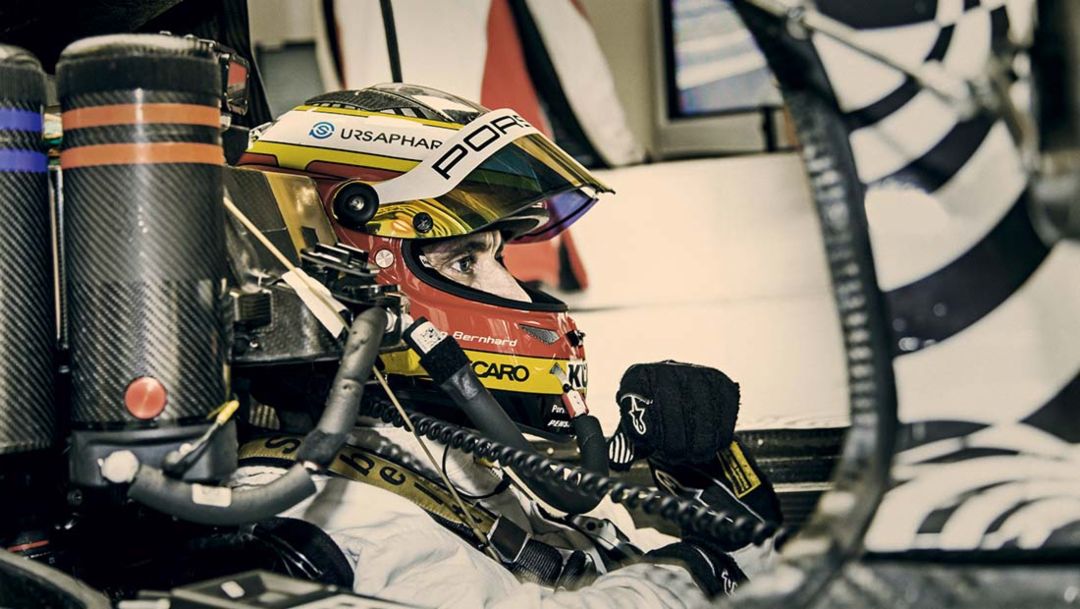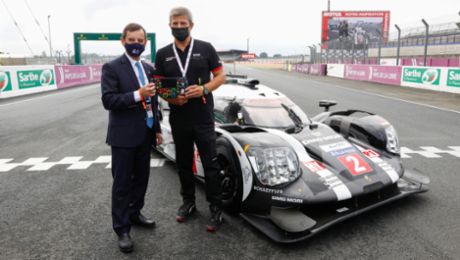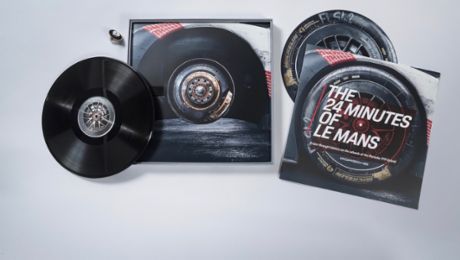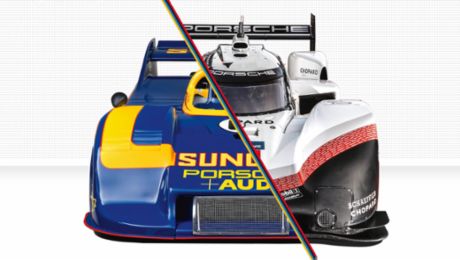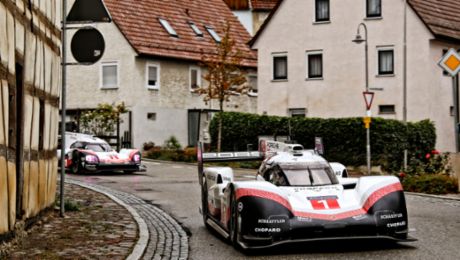Charged Up
Development work on the Le Mans prototype—the 919 Hybrid—has been running full speed ahead. The factory team has been testing this complex racing car since the summer of 2013. We joined them in Monza.
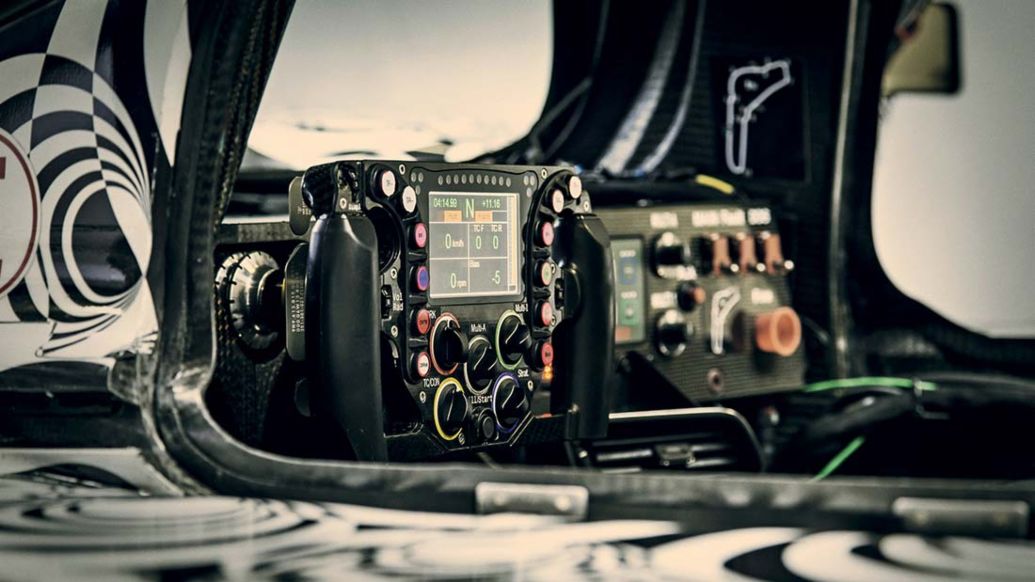
Alpha position four, Timo, alpha four,” intones a calm but firm voice on the headphones that
enable radio communication between the racing engineers and the drivers. “Alpha four copy, alpha four copy!” comes the response fractions of a second later from the cockpit of the LMP1 racing car, against a background hum of nearly 300 km/h. LMP1 factory and development driver Timo Bernhard confirms the instruction from his racing engineer Mathieu Galoche and turns switch A, as in “alpha,” on the steering wheel to the desired position. Some 22 dials and buttons are arrayed on the panel atop the steering column.
Andreas Seidl, the team leader and head of operations, explains the purpose of the special radio terminology. “What we’re trying to do is pack as much information as possible into just a few words. Information has got to keep flowing even when things get hectic.” Seidl went so far as to consult a fighter pilot from the German Air Force on this topic. “He gave us an idea of their radio communications and how they work in military engagements, and we learned from that. We’ve now introduced that type of radio discipline to our LMP1 team.”
Around 70 percent of its 5.793 kilometers are driven with the gas pedal to the floor
It’s easy to understand the reason behind this. Some of the information in radio communications is often lost or obscured. If an engineer tells a driver “no pit stop,” for example, and the driver hears only the last part “pit stop,” then he’ll make the mistake of driving to the pit, which would be a disaster in a race. So the first thing about instructions is that they always tell drivers what they should do instead of what they shouldn’t. The instruction “stay out,” for example, might be used instead of “no pit stop.” And the second thing is that the drivers always have to confirm, using the two-syllable word “copy,” which is much safer than just a brief “yes.”
The site of action is Via Vedano n° 5 in Monza, Italy. Here, in the midst of a wonderful park, lies the Autodromo Nazionale di Monza. This racetrack right outside Milan is notorious for its high proportion of full-speed segments. Around 70 percent of its 5.793 kilometers are driven with the gas pedal to the floor. “This place shows you whether an engine is really robust,” says Alexander Hitzinger, technical director of the LMP1 team. “The course is a big challenge for the complex hybrid drive of the new LMP1 generation. So we’ve integrated it into our test program at a relatively early point in order to filter out weaknesses.” As LMP1 director Fritz Enzinger adds, “Every test kilometer is extremely important to us.”
A cold start would not sit well with the direct-injection Turbo engine
The team of around fifty people has been on the course since seven in the morning, preparing the car and setting up the equipment in the pit. An external tankless water heater is connected with the cooling and lubrication circuits on the 919 Hybrid to bring all of the fluids up to operating temperature. A cold start would not sit well with the direct-injection Turbo engine. The car’s wheelless chassis rests on massive supports in the middle of the pit, nearly all of its body parts still missing.
By 7:30 a.m., the preparations for starting the engine are finished, and the engineers in charge give the green light. “Fire up” is what the first start is called, followed immediately by “pit run.” As Seidl explains, “That means we shift the gears up and down and bring the engine up to the right temperature. We then conclude the program by checking all of the car’s systems.” At 8:00 a.m. there’s a final briefing for the entire engineering team and the lead mechanics. Now the drivers are also involved. The day’s agenda is run through once again. At 8:45 there’s a final radio check. At 8:50 the driver climbs into the seemingly tiny cockpit. It looks like it might belong more to a plane than to a car. Racing engineer Galoche asks two brief questions via radio: “Engine ready? Systems ready?” The relevant engine and hybrid system engineers answer in the affirmative. Precisely at 9:00 a.m. the car rolls out of the pit. Every movement and every action of the entire team follows a set scheme. The test program is starting.
Before we can even arrive at this moment, a whole set of machinery needs to be put into place. The racecourse has to be booked up to a year in advance. Two of the company’s own racing trucks plus two rented 30-ton semitrailers bring the LMP1 racers and materials onto the track. Tire partner Michelin has also sent two trucks. On-site preparations begin two days before the first test run. In 2013 alone, the LMP1 team carried out ten of these test runs of three to four days each at international courses.
Timo Bernhard keeps pushing the prototype’s limits in Monza. The high curbs in the narrow chicanes present a special challenge to the 919 Hybrid. “The curb is part of the ideal line in racing,” he says. “Even in endurance racing. The regulations say you’re allowed to drive on it, so that’s what we’re doing.” The car is nearly knocked over in the process, running for an instant on only two wheels. As Bernhard explains, “We often have situations in races when we suddenly have to swerve around a slower car. And sometimes the only way to do that is over the curb.” On the course in Le Mans, the car literally flies over the high curb in the last chicane before the start–finish stretch—lap after lap, for 24 hours. The Porsche LMP1 has to master this hurdle as well.
Timo Bernhard: Monza is one of the world’s magical places
Here in Monza, it’s the first chicane, Rettifilo, and the second one, Variante della Roggia, that are giving Bernhard a good shake. For Bernhard, who joined the Porsche factory team in 2002, driving in Monza is always a special experience. “Monza is one of the world’s magical places,” he says. “You can still see the old steep curves here, which they even used for Formula One races until 1961. Amazing! If you try to run up them, you can hardly stay on your feet.” Bernhard drove his first race in Monza in 1999, in the Formula Ford European Championship.
Fourteen years later he’s now doing test-drives for what may be the most ambitious racing project in Porsche’s history. In developing this highly complex hybrid racing car, the Porsche engineers had to start from a blank slate. There weren’t any templates. A positive consequence is that they had to utilize many new technologies in keeping with the regulations, which will also be relevant for Porsche standard-series cars in the future. In addition, the engineers faced the extraordinary task of incorporating hybrid components and cutting-edge energy recovery systems into a car for endurance racing.
The lights in the pit won’t go out for hours at least
Development work on the 919 Hybrid leading up to the first race has also posed special challenges to Bernhard as an LMP1 factory driver. “A day of testing is almost tougher than a day of racing,” he says. “You’re in the car much longer. It demands a lot from you mentally, especially, because your racing engineer expects detailed feedback. That’s very important for this stage of development. As far as I’m concerned it’s a lot of fun because you’re challenged in every way as a driver.”
It’s 5:30 p.m. in Monza. Racing engineer Galoche radios to the driver of the 919 Hybrid, “Pit Timo, pit now!” Timo gives a short “Copy!” in response. The flat racing car in its camouflage exterior drives to the front of the pit for the last time today, and a few seconds later is rolled into the brightly lit garage. Silence suddenly descends on the racetrack in Parco di Monza, and the day of testing is over. But the lights in the pit won’t go out for hours at least. For now, the last radio message tells everybody in the vicinity that the high-voltage hybrid system has been switched off and the car is no longer wired: “Car is safe!”
Information
Text first published in the Porsche customer magazine Christophorus, Nr. 365
